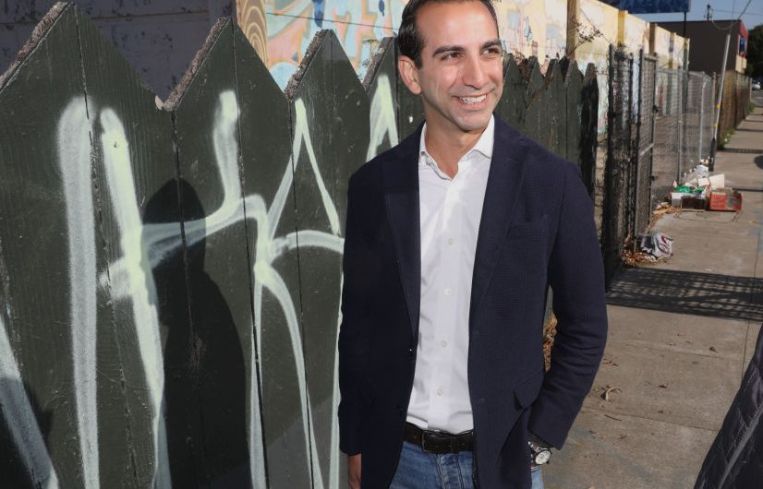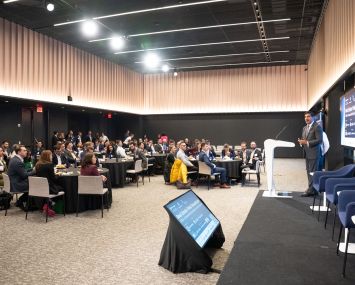Presidio Bay Summer Program Aims to Aid Real Estate’s Next Generation
The Bay Area development firm wants students to brainstorm their dream project
By Anna Staropoli August 1, 2023 4:36 pm
reprints
In the summer of 2021, Aurion Wiley Greene stood before an empty parcel of land in San Francisco’s Dogpatch neighborhood. As an industrial area known for its historic shipyards, the neighborhood presented a unique opportunity for the task at hand: brainstorming a potential development, as well as its potential uses and benefits in the community.
“That just opened my mind because I grew up down the street from the area,” said Greene, one of 12 inaugural students in a scholarship program offered by development and investment firm Presidio Bay Ventures. “Never before have I got the opportunity to do something like that, especially in my city.”
This community-centric approach distinguishes Presidio Bay’s scholarship program, which the developer launched in 2021. Based in the Bay Area, Presidio Bay takes a hands-on approach to introduce students to commercial real estate — and provide industry access to students from underrepresented, underserved and marginalized communities. It’s one of the initiatives that have taken root since the industry-wide DEI reckoning in 2020, which highlighted the need for increased inclusion in the industry.
Presidio Bay has addressed the issue one student cohort — and development model project — at a time. Its program tasks students with answering the fundamental question: “If you had a say in what [a development] could provide for you, even if you didn’t live there or work there, what would that look like?” said Kabir Seth, a principal at Presidio Bay.
Their answers range from child care facilities to basketball courts, pools and even restaurants that employ students from the neighborhood. For Greene, the Dogpatch development she imagined was a school, for which she considered how to maximize foot traffic and activate the space. She ultimately considered a rooftop that would take advantage of the location’s view of San Francisco Bay.
Since that model exercise in creativity, 24 students, including Greene, have graduated from the summer program — with more than $50,000 allocated in scholarship funding.
By now, it’s well known that real estate has historically discounted people of color and women, among other minority or marginalized groups. Real estate development is an industry dominated by white, cisgender men, where you often have to know somebody or be related to somebody, said Jonathan Dena, a member of the program’s 2023 summer cohort.
The last two months in the scholarship program, however, have helped Dena understand the opportunities available to him. “Not just because of my skills and my talent,” he said, “but also just because [the industry wants] to include diversity and a new lens of what real estate development is.”
Presidio Bay’s scholarship program joins similar endeavors implemented across commercial real estate. Over the last few years, student-centric real estate programs have cropped up throughout the country.
Such initiatives are grounded in great intentions and great visions but can get bogged down if the organizations take on too much, said Seth. No one organization should feel the full burden of having to solve the big and complex problem of access, equity and inclusion, he added.
Instead, Presidio Bay leverages the larger ecosystem of commercial real estate by introducing the students to mentors from a variety of different organizations. These leaders, often industry professionals from different companies, teach students about construction, tech, finance, land use and the like, often exposing them to new specialties. For example, Rafael Mandelman, who represents District 8 on San Francisco’s Board of Supervisors, recently visited this year’s cohort to speak with the students.
“We’re all standing on the backs and shoulders of people who helped us get to this position,” said Seth. “Let us tell you what we do. Let us show you how we got here.”
For Dena, opportunities for mentorships — particularly from Seth himself — drew him to the program. While taking a real estate class at University of California, Berkeley, Dena met Seth, who was giving a guest lecture about development. At the time, Dena didn’t know any developers and welcomed the chance to network. Now, after each of Presidio Bay’s mentorship workshops, Dena reconnects with the program’s guest speakers via Zoom for informational interviews.
“One of the biggest overarching goals of the program is to break down this sort of mystery and opaqueness around what a career is and what it looks like,” said Seth. “When you grow up, it’s often very easy to fall into the trap of thinking that career success and career growth is very linear.”
The common assumption for post-grad life looks a little something like this: You leave college and get a job that will, in turn, lead to the next job. Consequently, young people face all kinds of pressures and anxieties; they often question whether they’re making the right choice for what they perceive as a linear future, said Seth.
“You’re gonna do one thing,” said Seth, “and then you’re gonna find something else and the economy is gonna change and technology is gonna change and you’re gonna go into multiple different directions.”
Granted, the scholarship program is not a Ph.D. study in architecture or finance, said Seth. However, it’s enough to influence decisions and career paths — even if a student ultimately chooses not to pursue commercial real estate.
“Of course, we want them to stay in the real estate industry,” said Alexis Stewart, Presidio Bay’s program manager. But regardless of where they go, she wants to instill in them a sense of empowerment — “just enabling them to know that they have the power to have a seat and a voice at the table.”
In addition to mentorships and hands-on projects, the program’s curriculum also includes public speaking courses, as well as workshops for students to develop resumes, LinkedIn profiles and even professional headshots.
Greene — who has, indeed, remained in the real estate industry as a planning intern at the City and County of San Francisco — has already utilized the scholarship program’s lessons. Her current role focuses on funding affordable housing, and returns to the development fundamentals she learned two summers back.
Even for students still in the program, lessons are already transitioning directly into communities. In particular, Dena has learned how to tell the story of a given neighborhood and understand not only the land but also the people who live there. There’s a stigma that developers come in and disrupt neighborhoods, said Dena, but that’s not always the case. “A lot of these developers want to come in and assist and help these communities grow.”
“We’re not telling [students] that we’re going to suddenly do what the community wants to do because there’s economic factors and other factors that drive our decisions,” said Seth. “But if [students] have a vision for what [they] want to do, here are the players involved; here’s the process involved.”
Students can then chart their own courses of action through those parameters. Back in San Francisco’s Dogpatch Area, as well as the nearby Pier 70, Dena engaged directly with the community. Alongside his team of fellow scholarship students, Dena conducted community surveys; he asked neighborhood businesses what they like about the area — and what they wish they had.
“It’s crazy to say,” said Dena, “but [I feel like] I’m a part of the community just by having this opportunity to learn about them and to speak with them, engage with them.”
Engaging directly with San Francisco’s neighborhoods not only brings community into focus, but, again, also helps students shape and reshape their own worldviews. Greene, who grew up in San Francisco’s Bayview area, gained an understanding of how buildings can change dynamics, activate a space and anchor a community.
“I didn’t even know that it would be this impactful,” she said. “I thought I would just be learning something, but [it’s actually changed] my lifestyle, like the way I view the world.”
Presidio Bay’s community-centric approach isn’t limited to just the scholarship students. For mixers and events, Presidio Bay also employs minority-owned, community businesses whenever possible. You not only have a circle of impact for the students, but also for the community, said Stewart. “I do not believe in intention,” said Stewart. “I believe in impact.”
As demand surges, however, expanding that impact is no easy feat. This summer, Presidio Bay saw the number of student applications more than double; over 100 students applied for 12 or 13 positions. Seth, who believes applications will continue to rise, acknowledges that some students, unfortunately, simply won’t be able to participate; the need for quality and attention to students requires a small cohort size.
Yet, over time, Seth hopes that the scholarship model will expand into other cities across the country. Presidio Bay may be based in San Francisco, but so long as partners are willing to spend time and energy contributing their expertise, the scholarship program’s model can be easily replicated, said Seth.
As more students apply for the program — and, in turn, more professional partners join Presidio Bay — the network will ultimately become all the stronger for the scholarship students. The program equips students with everything they need to build a career in real estate. So even if you don’t come from an industry background, you can feel embraced, encouraged and empowered for the future, said Dena.
“The way this program is structured,” said Dena, “it’s like the difference between receiving a handshake and a hug.”


